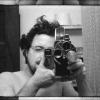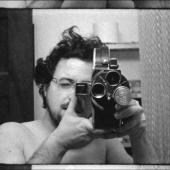Dialogue 2: Action films are static

Hi Alan!
This was the paragraph that really caught my attention:
As a strange result, it occurs to be that stage acting v. screen acting isn’t just about being big or being intimate. Stage acting requires an actor to constantly be doing actions, striving for goals, making things happen, revealing and hiding emotions in the context of a three-dimensional environment that, maybe surprisingly, is actually a bit more like our world than the stories we tell on screen. The actor’s focus and energy and intentions become our focus and energy and intention. Screen acting on the other hand requires the opposite. The heavier reliance on plot carries us forward actively and the editing and the direction control our focus. The film and television actor’s job is to just show emotion.
It strikes me that in film, we’re always talking about action – the director says “action!” for every take, and there’s a pervasive idea that a film set is an immensely kinetic environment, things swooping around and exploding, fight scenes, etc.
Most people who visit a film set for the first time, in contrast, are shocked by how static it seems to be. When I’ve worked on films in public, outdoor locations, lots of passers-by ask if they can hang around and watch. I generally say yes, because I know they won’t last for more than 15 minutes. Things are happening, in the sense that a light is being adjusted, a lens is being brought in, someone’s makeup is being fixed – but from the outside it looks like a bunch of people standing around, waiting.
When you do get to do something – say a shot where someone runs down a hallway and slams a door – you usually do it a dozen times, and after each one, everything is reset, every trace that this has happened before is erased.
So, you may have a crew of 150 people working hard for a 14-hour day, but the “action” that will wind up on screen from that day is maybe 90 seconds, if you’re really efficient.
It seems like the way filmmaking has evolved, in the last hundred years, is for everything to move around the actors, but for the actors themselves to move very little. Like you mentioned, the camera “tracks in” or zooms in to show that this moment or reaction is significant, or a steadicam or crane glides around the room, whereas the actor moves as little as possible, gives as subtle a performance as they can – their eyes glisten, for example. A single, understated tear makes its way down somebody’s cheek. They grieve.
So you have all this inertia, all this weight, to support dramatically with these extremely minimalist actions – the actors are carrying the entire crew and all the equipment on a single eyebrow.
No doubt, great screen actors can bring the entire apparatus to life – but I don’t think we often recognize the heavy lifting involved, that makes the stars stars – the ability, for a split second, to lift all that crushing, industrial weight and have an authentic, subtle reaction. Fifteen times in a row, over the course of 4 hours.
The fact that these are different art forms with different dynamics and metrics for success doesn’t particularly bother me, but I am interested in and troubled by what the audience takes away from all of this.
It always amazes me, when I watch a big action movie, how static it actually is, most of the time. There’ll be a dinosaur attack or whatever, but then people will stand around and talk about it for 20 minutes. So we spend most of our time in front of the screen watching actors not moving, standing quite still actually (so they can remain in focus) while they talk about what just happened or what will happen next.
So our sense of the way the world works, via the movies, is that people don’t act, in the sense of “take action.” They stand around and discuss until something happens and they have to react to it, whether it’s alien invasion, ingenious jewel heist, etc..
And meanwhile, the audience member sits still watching all of this, pretty much completely passive. It can be quite stifling and claustrophobic, in spite of the vast scale of production and the universes we’re being shown on screen.
We’ve had over a hundred years, via movies then television then the interwebs, to learn (or from a more sinister perspective, to be trained) not to act – to passively observe and absorb, to sit apart from whatever action may be going on, comfortable in the fact that it doesn’t impact us at all, our emotional engagement is entirely voluntary and contingent on our pleasure.
Leading, today, to a world in which our most effective form of political protest is to literally sit in the freeway, blocking traffic. Which, don’t get me wrong, is a brilliant tactic – I’m just struck by the fact that it seems to be the only type of “action” that works.
In my own films, I try to spend as much of the process as possible in motion, with the camera. The subjects of my films are usually events unfolding in front of me, so there’s not a lot of stopping and waiting at all. When I do film, I try to use my reflexes, so that my eyes and hands are working together as freely as possible, without my brain getting in the way too much.
I recently taught a class called “Acting and Directing,” which was a stretch for me, since I have experience directing actors but not acting myself.
The film students in the class (a few of whom had some acting experience) were amazed that I was asking them to do things with their bodies. We laid on the floor and meditated. We went out into the skyways of Minneapolis and observed people, studying the way they walked and learning to mimic them, then bringing those walks back to class to share with one another.
I’m impressed by how theater seems to still value moving and feeling, learning to observe, execute and share that motion and emotion with others. It seems more and more like a skill we all need to practice, as adults at least, since we’re pretty good at sitting, standing and walking through our lives, but that most of us don’t use our bodies for much else.
I wonder too, about the audience: going to a play, I think it’s true that more is demanded of me, I have to track what’s going on emotionally, look around the stage, “follow” in a way that movies don’t often require anymore. But it still seems like a mostly passive relationship, sitting in the dark.
I’m not saying that I think theater should be entirely participatory, “breaking down the fourth wall,” site-specific, improvised – and it’s not that I’m a huge advocate of interactive media, virtual or enhanced reality either – so I don’t know that any of this represents a problem to be solved or innovated away. Maybe I’m just already a curmudgeon who can never foresee myself downloading Pokemon Go.
What do you think, Alan, about where theater stands in all of this; the active, the passive, the engaged, the embodied? Are we just two crusty complainers? Or is there something worth digging into further here?
Kevin




